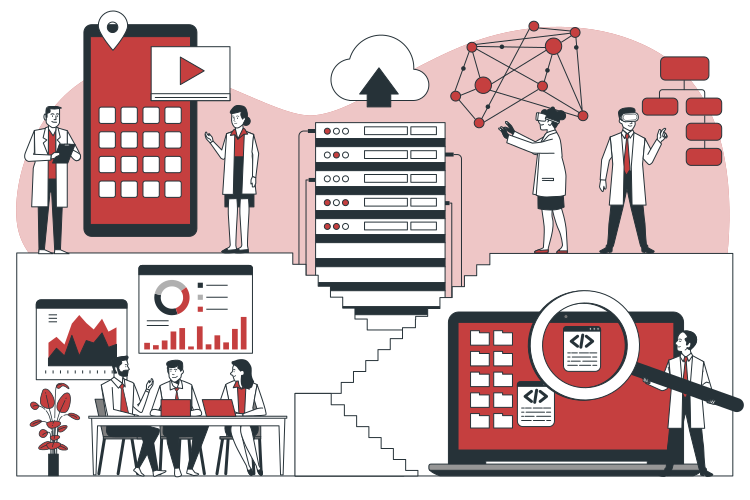In the competition to build smarter, faster, more innovative tech teams, many companies are chasing the same credentials, the same job boards, and the same talent pools. But what if your biggest competitive edge isn’t more of the same—but a different kind of mind altogether? Neurodiversity in the workplace is not just a matter of inclusion—it’s a high-impact innovation strategy. So, by welcoming cognitive differences like ADHD, autism, dyslexia, and more, remote tech teams can unlock new layers of problem-solving, creativity, and performance that standard hiring pipelines often miss.
In today’s huge competitive tech landscape, innovation isn’t just desirable—it’s imperative. Therefore, organizations are continually searching for new ways to outpace their competition, solve complex problems, and design products that are intuitive, efficient, and impactful. However, one of the most untapped sources of innovation lies not in new tools or technologies, but in the people we choose to hire—and more importantly, in those we overlook.
Embracing neurodiversity in remote tech teams
Neurodiversity in the workplace is proving to be a critical engine of innovation in the tech sector. Neurodivergent individuals—those with cognitive differences such as ADHD, autism spectrum conditions, dyslexia, and more—bring unique perspectives that can enrich problem-solving, drive creativity, and elevate team performance. Unfortunately, many traditional hiring practices filter out this talent, not because of lack of skill, but due to systemic bias in how we evaluate communication styles, social behavior, or resume gaps.
As hiring continues to go global and remote, it is imperative for remote-first companies to rethink hiring models and embrace inclusivity as a core strategy for innovation.
What Is Neurodiversity—and Why Does It Belong in Your Tech Hiring Strategy?
Neurodiversity refers to the full range of natural variations in human cognition, including how individuals perceive, process, and interact with the world. Unlike medical models that categorize ADHD, autism, or dyslexia as disorders to be "fixed," the neurodiversity paradigm views these differences as part of the broader human spectrum—each offering distinct strengths and challenges.
In a tech context, these differences are not liabilities—they're assets. For instance:
- Autistic individuals may demonstrate incredible pattern recognition, focus, and logical consistency.
- People with ADHD often thrive in fast-paced environments and can hyperfocus on problem-solving tasks.
- Those with dyslexia frequently excel in visual-spatial reasoning and holistic thinking.
Therefore, when your tech team includes neurodiverse thinkers, it gains new cognitive dimensions that can lead to better code, more innovative products, and smarter systems. Embracing this diversity ensures that your hiring strategy is not just fair—but future-proof.
Five Business Benefits of Embracing Neurodiversity in the Workplace
Welcoming neurodivergent talent into your teams isn’t just good for morale—it’s good for business. In fact companies that actively support neurodiversity reap clear, measurable benefits in performance, innovation, and brand reputation.
1. Increased Innovation and Creative Problem Solving
Innovation thrives when teams can look at challenges from multiple perspectives. Neurodivergent professionals often bring a fresh lens that isn't constrained by conventional thinking. This can result in solutions that others might not consider. For example, an autistic software developer might identify an overlooked flaw in a system’s logic that improves overall architecture. In product design, someone with dyslexia might intuitively spot usability issues because they process information differently.
2. Higher Productivity in Key Technical Roles
When supported properly, neurodivergent individuals often demonstrate remarkable performance in specific tech roles. Their ability to concentrate deeply, spot anomalies, and work independently aligns well with many remote roles in software testing, development, cybersecurity, and data analysis. According to Deloitte Insights, teams with neurodivergent professionals in some roles can be 30% more productive than those without them.
3. Improved Retention Through Meaningful Inclusion
Retention is a major challenge in the tech industry. Inclusive environments that accommodate neurodiverse needs—whether through flexible schedules, structured workflows, or supportive communication—result in greater employee satisfaction and loyalty. Neurodiverse individuals who feel valued tend to stay longer and invest more in their roles, thus reducing hiring and onboarding costs over time.
4. Enhanced Employer Branding and Talent Attraction
Today’s job seekers are mostly the Gen Z candidates. They are deeply attuned to values like inclusion, psychological safety and ethical business practices. Hence, companies that promote neurodiversity not only appeal to this new generation of talent but also build stronger employer branding among clients, partners, and investors. Inclusive hiring practices are definitely becoming a mark of forward-thinking leadership.
5. Stronger Team Decision-Making and Diversity of Thought
Cognitive diversity leads to richer discussions, more balanced risk assessments, and ultimately better decisions. In agile methodology, where cross-functional collaboration is essential, neurodiverse team members contribute alternative viewpoints that prevent groupthink. They also promote better planning, iteration, and execution.
The Cost of Ignoring Neurodivergent Talent in Traditional Hiring Models
Most hiring systems remain optimized for neurotypical behavior. From vague job descriptions to ambiguous interviews focused on cultural fit, these processes often exclude highly capable neurodivergent individuals. This exclusion results in a loss of talent, innovation, and competitiveness.
Companies that fail to adapt not only miss out on talent but also risk reputational harm. In contrast, organizations that proactively include neurodiverse individuals build teams that are more adaptive, resilient, and innovative. The status quo is no longer acceptable in an era where diversity is closely tied to market success.
Inclusive Hiring for Tech Teams: Practical Ways to Attract Neurodiverse Talent
To tap into the benefits of neurodiversity, companies have to reimagine their hiring frameworks:
- Compelling IT job descriptions should be written in clear, concise language. Specify the actual outcomes expected rather than vague personality traits.
- Application processes should offer alternatives for different communication preferences.
- Interview formats should reduce pressure and ambiguity—provide questions in advance or allow written responses.
- Assessment techniques should shift from social performance to real-world skills.
Platforms like Utkrisht are already helping remote tech companies embrace a skills-first model. Hence, it ensures talent is judged on capability and not conformity.
Building a Remote Workplace That Supports Neurodivergent Employees
Hiring neurodiverse talent is the first step. However, sustaining their success requires creating systems that support their unique strengths:
- Structured flexibility allows individuals to manage their energy and focus effectively.
- Asynchronous workflows reduce communication overload and cater to different processing speeds.
- Accessible communication tools like visual task managers or shared documentation help reduce misunderstandings.
- Training for managers and peers fosters empathy, reduces stigma, and encourages collaboration.
When combined, these changes not only help neurodivergent employees thrive but also improve team clarity and reduce burnout. Hence it enhances productivity across the board.
Companies That Reaped Rewards from Neurodiversity Hiring
Top companies like SAP, Microsoft, and JPMorgan Chase have invested in neurodiversity hiring programs and reported exceptional results:
- SAP’s Autism at Work program led to innovation in software QA processes.
- JPMorgan Chase’s Autism at Work initiative saw productivity gains of over 100% in certain tech functions.
- Microsoft’s Neurodiversity Hiring Program has improved hiring outcomes and team collaboration.
Thus, these examples demonstrate that inclusive hiring is not a "feel-good" initiative. In fact it’s a proven business strategy.
How Utkrisht Supports Neurodiverse Hiring in Remote Tech Teams
At Utkrisht, we’re committed to helping companies build inclusive, remote-ready tech teams. We enable a hiring process that removes barriers and amplifies strengths. Our platform supports:
- Bias-free candidate discovery
- Project-based assessments tailored for cognitive diversity
- Support for inclusive onboarding strategies
We help you identify and retain talent who may otherwise be overlooked—and who can become the strongest contributors to your growth.
Inclusive Tech Teams Start with Inclusive Thinking
Neurodiversity in the workplace isn’t a checkbox—it’s a strategic imperative. Remote tech teams that value cognitive diversity outperform their peers in employee retention, innovation, and long-term adaptability.
Therefore, by rethinking how you hire and how you support different minds at work, you unlock powerful new pathways to growth. The future of tech isn’t just digital—it’s diverse.



